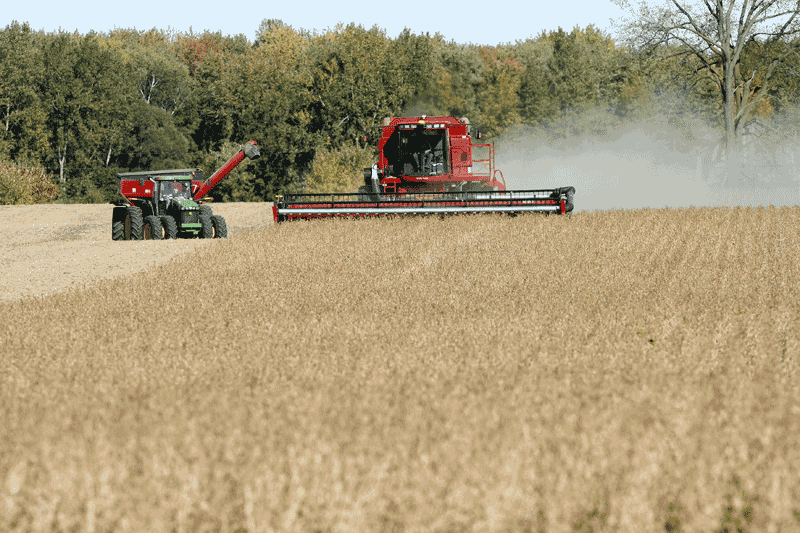Attention to detail
FINE TUNING FOR AN OPTIMUM WINTER WHEAT CROP
the key to an optimum winter wheat crop is to pay close attention to the details. That is the word from Barry Gordon, Ontario sales manager for C&M Seeds. He shared a number of points that are critical from the time the seed bed is prepared for planting until the wheat is harvested.
“It’s a whole bunch of little things together that help meet the goal of a field that comes out even and at its best,” he says.

finding treasure in the ‘trash’
Top priority in Gordon’s mind is maximizing the green manure value left by the previous crop’s residue. He says the challenge in achieving this with combines built in the past decade is the chopper and spreaders have not kept pace with the dramatic increase in header widths.
“The straw chopper and chaff spreader are meant to distribute residue across the entire width of the header,” he says, adding this even spread of residue is critical to building a good seed bed.
It was achievable in the 1980s and 1990s when headers were 15-20 feet, Gordon says, but now they commonly span 25-40 feet. Unless properly adjusted, the spread pattern can easily become thicker down the middle and thin on the fringes of the combine’s pass. Under the heavy chaff layer will be damp soils the sun can’t reach, while on the fringes the ground will be drier. As the chaff breaks down, its nutrients also distribute unevenly.
It may seem trivial, but Gordon sees how poor attention to distribution will have carry over effects with crops planted in the following years. “It’s not enough to think you can plow or cultivate it after to move those nutrients and material around,” he says. “It only moves inches, not feet.”
Gordon says it is like renting a fertilizer spreader that is supposed to have a 50 foot pattern and it malfunctions and puts out only 25 feet. “Wouldn’t you be bothered that the investment you made in fertilizer wasn’t being maximized?” Phosphorus, in particular, doesn’t move far in the soil; staying where it is spread. “Those stripes of phosphorus will make it near impossible to get even crop growth in the coming years,” he says.
With a bit of time, most combines can be adjusted to improve their spread pattern, Gordon says. For the odd machine that still can not be adjusted to spread as wide as the header, he has seen some growers successfully use aftermarket choppers and spreaders available from a company in Saskatchewan.
competition free
For wheat to get started on the best footing, Gordon says it needs to be planted into a weed-free environment. After the soybean rotation, lingering perennial weeds such as dandelion, Canada fleabane and sow thistle can smother establishing wheat.
Gordon says an application of glyphosate one week to 10 days before soybean harvest, or on the stubble, can be effective at knocking out competition.
a jump start
Gordon has seen the benefits of using seed-placed fertilizer alongside wheat at planting. “No matter the soil test, there are benefits to placing the fertilizer in the furrow with the seed,” he says, adding a typical response is an increase of five to six bushels per acre. If conditions are cold and wet immediately after planting, Gordon says the response can be greater still. An additional boost comes from using seed treated with Cruiser Maxx Vibrance, Gordon has found, noting it seems to give an increased vigour effect on top and at the roots.
There are mixed feelings about under seeding among growers. Gordon suggests it is possible to achieve a really good under seeded crop and a really good wheat crop. He is a firm believer in under seeding; and maintains red clover is still the best cover to put into wheat on a routine basis. The key, he feels, is broadcasting the red clover early (late February to early March) on frozen ground. Gordon says once the wheat is harvested, the red clover that has been establishing itself below will take off in growth.
Gordon has noticed the majority of growers are using increased nitrogen rates: 120-130 units per acre on soft red and 150-160 on hard red. It is a quick way to boost yield by as much as 15 bushels per acre, he says.
While hard red wheat yields are increasing – the protein values have been slipping. Gordon says some growers are adopting a European approach by dividing their nitrogen into two applications on wheat. “It’s cost effective and paying back,” he says. With nitrogen typically applied in late April, it can be hard to maintain its availability for the period from flowering to maturity when nitrogen is taken up to make protein. With the European approach, half the nitrogen plus sulfur is still applied early, then, the remaining nitrogen is applied 10 days to two weeks before flag leaf emergence.
Gordon says challenging growing conditions may discourage some growers from wheat. But he feels there are reasons to be excited about wheat — especially hard red varieties.
“Our domestic market needs more than we supply,” he says. “If we can put a bit of time and effort in to achieve those protein levels, we have a ready market in Ontario for hard red wheat.” •








